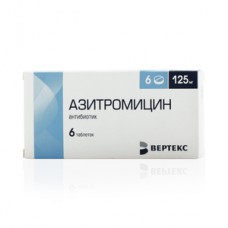Expiration date: 03/2025
Composition:
Azithromycin, 9-dioxi-9a-Aza-9a-methyl-9a-homoerythromycin a dihydrate, basic physico-chemical properties: solid blue gelatin capsules No. 00 (for a dosage of 500 mg), No. 0 with a red lid and a red body (for a dosage of 250 mg), No. 2 yellow (for a dosage of 125 mg) , containing white powder or almost white powder, composition: 1 capsule contains azithromycin in terms of 100% mg, 250 mg or 500 mg,
auxiliary substances: lactose monohydrate, sodium lauryl sulfate, magnesium stearate.
Pharmacological properties:
Pharmacodynamics. Broad-spectrum antibiotic belongs to the subgroup of macrolide antibiotics – azalides. At high concentrations, the bactericidal effect is possible.
Azithromycin is active against aerobic gram-positive bacteria: Streptococcus pneumoniae, Streptococcus pyogenes, Streptococcus agalactiae, Streptococcus spp. groups C, F and G, Streptococcus viridans, Staphylococcus aureus, aerobic gram-negative bacteria: Haemophilus ducreyi, Haemophilus influenzae, Moraxella catarrhalis, Bordetella pertussis, Bordetella parapertussis, Legionella pneumophila, Campilobacter jejuni, Helicobacter pylori, Neisseria gonorrhoea, Gardnerella vaginalis, anaerobic bacteria: Bacteroides bivius, Clostridium perfringens, Peptostreptococcus spp.
The drug is also active relative to Chlamydia pneumoniae, Chlamydia trachomatis, Mycroplasma pneumoniae, Ureaplasma urealyticum, Borellia burgdorferi.
Pharmacokinetics. Absorption: azithromycin is rapidly absorbed in the gastrointestinal tract. After taking the drug orally at a dose of 500 mg the maximum concentration of azithromycin in plasma achieved through 2, 5-2, 96 hours and is 0, 4 mg/l. Bioavailability is 37%.
Distribution: azithromycin penetrates well into the respiratory tract, organs and tissues of the urogenital tract (in particular, the prostate gland), the skin and soft tissues. High concentration in tissues and a long half-life due to low binding of azithromycin to plasma proteins of blood.
Azithromycin remains in bactericidal concentrations in inflammation within 5-7 days after your last dose.
Metabolism: it is metabolized in the liver, losing activity. The use of food significantly alters the pharmacokinetics.
Vvedennya: 50% vivodina with bile in an unmodified form, 6% from urine.
Indications for use:
Infectious-inflammatory diseases caused by sensitive to the drug pathogens:
- infection of ENT organs (angina, sinusitis, tonsillitis, otitis media),
- scarlatina,
- respiratory infections (bacterial and atypical pneumonia, bronchitis),
- infections of the skin and soft tissues (erysipelas, impetigo, secondary infected
- dermatosises),
- urogenital tract infections (uncomplicated urethritis and/or cervicitis),
- Lyme disease (boreliosis) in the treatment of the initial stage (erythema migrans),
- diseases of the stomach and duodenum associated with Helicobacter pylori.
Method of application and doses:
Inside for 1 hour before or 2 hours after a meal.
Adults with infections of the upper and lower respiratory tract, skin infections and soft tissues are prescribed 500 mg/day for 3 days (course dose – 1, 5 g). Children weighing more than 15 kg are prescribed at the rate of 10 mg/kg body weight once a day for 3 days. Course dose – 30 mg/kg.
In uncomplicated urethritis and/or cervicitis adults appoint a one-time 1 g.
In Lyme disease (boreliosis) adults for the treatment of the initial stage (erythema migrans) appoint 1 g in the 1st day and 500 mg every day from the 2nd to the 5th day (course dose-3 g). Children with a body weight of 15 kg on the first day in a dose of 20 mg/kg of body weight, from the 2nd to 5th day, and 10 mg/kg of body weight 1 time a day for 5 days.
In diseases of the stomach and duodenum associated with Helicobacter pylori, adults are prescribed 1 g per day for 3 days as part of combination therapy.
Children weighing more than 15 kg are prescribed at the rate of 10 mg/kg body weight once a day for 3 days. Course dose – 30 mg/kg Children over 12 years prescribe the drug in doses for adults.
In case of missing 1 dose, the missed dose should be taken as soon as possible. And the next-with a break of 24 hours.
Application features:
With caution, prescribe the drug to patients with impaired liver and/or kidney function.
During pregnancy and lactation, the drug is prescribed only if the expected benefit to the mother exceeds the potential risk to the fetus or child.
This dosage form (capsules) is not indicated for use in children under 5 years of age.
Side effect:
From the side of digestion system: nausea, diarrhea, abdominal pain, rarely – vomiting, flatulence, tranzithornoe increase in liver enzymes.
Possible skin rash, cholestatic jaundice, headache, drowsiness, nephritis, vaginitis, neutropenia or neutrophilia, photosensitization, eosinophilia. In children – excitement, insomnia, conjunctivitis, hyperkinesia.
Interaction with other drugs:
Antacids containing magnesium or aluminum hydroxide reduce the absorption of Azithromycin-Health. Therefore, it is recommended to adhere to a break of at least 2 hours between taking azithromycin and antacid drugs.
Azithromycin does not bind to the enzymes of the cytochrome P450 complex, so it does not interact with oral anticoagulants, carbamazepine, diphenine, digoxin, cyclosporine, ergotamine, but care should be taken while using them.
Contraindications:
Hypersensitivity to antibiotics of the macrolide group.
Overdose:
Nausea, vomiting, diarrhea, temporary hearing loss. The therapy is symptomatic.
Storage conditions:
Store in a dry, dark place at temperatures between 15°C and 25°C. Keep out of reach of children.
Shelf life-2 years.


